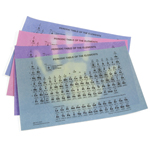Ammonite was once thought to be the petrified remains of snakes! Modern science, however, tells us that these fascinating fossils are actually the remains of an ancient aquatic mollusk. A mollusk is an invertebrate with a soft, unsegmented body. The soft body of an ammonite was protected by a hard outer shell. The shells of ammonites ranged from an inch to nine feet! Each shell is divided into many different chambers. The walls of each chamber are called septa. The septa were penetrated by the ammonite’s siphuncle, a tube-like structure that allowed the ammonite to control the air pressure inside its shell. Ammonites were aquatic creatures, and being able to control the air pressure inside their shells meant being able to control their buoyancy.
Goldenrod Paper
October 1, 2009Color changing goldenrod paper has been exciting students of all ages for decades to the wonders of chemistry! Imagine the enthusiasm of the first student or teacher who spilled a few drops of ammonia on a piece of yellow paper and observed it turn bright red! One can only image them exclaiming: “Super, Wow, Neat!!!”
Place the paper in a solution of household baking soda and the paper turns red; immerse it in vinegar and the red turns back to yellow! This goldenrod paper is colored with a dye that is an acid/base indicator: red in base and yellow in acid. The paper is similar to litmus paper that is blue in base and red in acid. Read the rest of this entry »
Heat-Sensitive Paper
September 11, 2009A short time ago I received the following inquiry regarding our Heat-Sensitive Paper. One of the joys of being the president of Educational Innovations is having the opportunity to answer questions like this.
Q: What chemical coats your Heat-Sensitive Paper that makes it change color? My chemistry class wants to know the chemistry of what is happening on our heat-sensitive periodic tables. Can you please help us?
help us?
A: Some of the characteristics of our heat-sensitive periodic tables are easy to understand and some more challenging. The inks used provide color at lower temperatures and are colorless at higher temperatures. The change over temperature is called the “critical temperature.” Adding heat to the paper causes the paper to loose its color, an “endothermic” reaction. The reverse, going from colorless to colored, is an “exothermic” reaction and returns the heat.
To manufacture this paper, long rolls of white paper are unwound, coated on one side, dried, cut, and finally stacked into reams. Read the rest of this entry »
Back to School Experiments with Sodium Polyacrylate
September 8, 2009 by: Tami O’Connor
by: Tami O’Connor
Though I am no longer in a traditional classroom, the end of each August still fills me with that feeling of eager anticipation and yes, even a bit of anxiety…. Then I remember, I’m not going to be facing a room filled with bright new faces nor will I need to develop the plethora of creative lesson ideas necessary to engage and stimulate young minds. But still, I enjoy sharing some of the school experiments that my students and I enjoyed.
One school activity I used to teach the scientific method required the use of an old favorite; Sodium Polyacrylate. This is the chemical powder found in disposable baby diapers. I would start my lesson with a 3 Cup Monty game in which I used 3 opaque cups that were identical in every way except that two of the cups were empty and in the third I placed about 3 tablespoons of the water lock powder.
My shtick started with me talking about the importance of observation skills. I would explain the necessity of having a keen eye. Shortly after my speech I would pour about 1/2 of a cup of water into one of the empty cups. While encouraging my students to carefully watch the cup with the water in it, I would move the cups around fairly slowly, knowing they would be able to follow the water filled cup easily, until the three cups ended in a line across my desk. Read the rest of this entry »
The Amazing Ostrich Egg
August 27, 2009 by: Ken Byrne
by: Ken Byrne
The ostrich is a member of the Ratite family, which also includes emu, rhea, cassowary, and kiwi. Ratites are distinguished as flightless and keel-less (having no breast bone) birds. Ostrich skeletons and fossils date back over 120 million years.
The ostrich, native to Africa, is the largest of living birds. Some males reach a height of 8 ft (244 cm) and weigh from 200 to 300 lb (90 – 135 kg), while females will range between 5.5 and 6.5 (170 cm – 200 cm) feet tall at maturity.
In the wild, a mature female will lay between 12 and 15 eggs after mating (at the rate of one every other day for several weeks). Ostrich farmers quickly remove the eggs from the nest to extend the laying season. In some cases, a domesticated hen can lay up to 80 eggs, although 40 to 50 is more typical. Ostrich eggs are the largest of all bird eggs and weigh about 2.75 pounds (1.2 kg). The contents of one ostrich egg can be equivalent to as much as two dozen chicken eggs. Read the rest of this entry »




 Posted by Tami O'Connor
Posted by Tami O'Connor 